With the advancement of finite element tools the analysis and design of huge and special structures is possible now-a-days. In this paper the analysis of airport integrated building has been carried using the finite element software SAP 2000. By considering the necessary functionality of the building, the number of columns required is reduced from 60 to 30 by introducing truss POD in the structural system. The building has been analysed using Response spectrum method as per IS 1893 and the dynamic responses are obtained.
Keywords |
| Airport building, Modelling, Seismic analysis, Dynamic Response |
AIRPORT TERMINAL BUILDING |
| Airports are important national resources which serve a key role in transportation of people and goods. The primary
buildings in airport consist of passenger terminal buildings, control towers, cargo buildings, hangars, airport
maintenance buildings and fire and rescue stations. To achieve sustainable developments the analysis and design of
airport buildings should focus on function, construction materials, construction technology and energy savings. |
| The essential functional requirement of the Terminal Building is a free space for the movement of passengers and
goods. One of the ways to get free space in the terminal building is having less number of columns with cautious
planning and design in terms of the safety of the structure. The design of any complex and superior building should
satisfy not only the vertical loads coming on the structural elements but also the horizontal loads such as wind and
earthquake forces. The new Integrated Terminal Building at Mumbai’s Chhatrapati Shivaji International Airport has a
long-span roof covering a total of 70 000 m2 over various functional requirements, making it one of the largest roofs in
the world without an expansion joint [1]. In this study a similar kind of airport terminal building system is modeled
using the finite element software SAP 2000 and is analysed for seismic resistance using response spectrum method as
specified in IS 1893:2002. The structural consists of steel moment resisting frames comprising of composite mega
columns and long-span steel rooftop trusses. |
MODEL OF STRUCTURAL SYSTEM |
| Modelling of the columns and the pod is done in SAP2000. The columns are assigned fixed support condition at bottom.
The upper end of the column is left free to join truss POD. The spacing of columns in X-direction is 32m and in Ydirection
is 64m as shown in Fig.1. The columns are being modelled with steel encased concrete properties of M 60
concrete and Fe 345 steel. The Modulus of elasticity obtained from the composite parameters is 2.32 GPA [2]. The
diameter of the column is assumed as 2.7m |
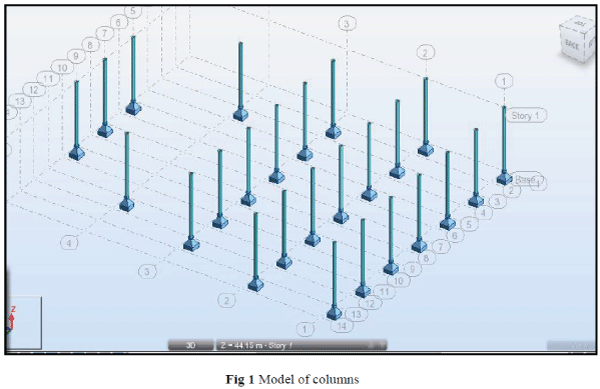 |
| The columns are being modelled with steel encased concrete properties of M 60 concrete and Fe 345 steel. The
Modulus of elasticity obtained from the composite parameters is 2.32 GPA [2]. The diameter of the column is assumed
as 2.7m. |
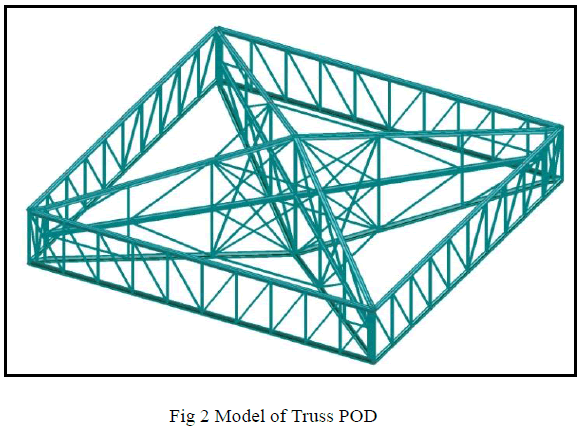 |
| The truss POD (Fig.2) is modelled with properties of Fe 345 steel. Hollow sections with 0.315 m diameter are
considered for this. This POD is modelled in such a way that it can transfer the load coming on it to columns in arch
action. The complete model of the structural system is show in Fig.3. |
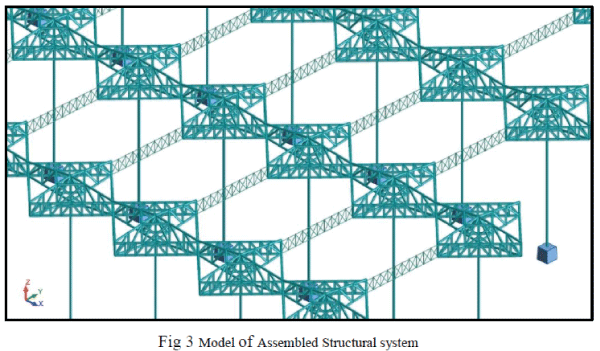 |
RESPONSE SPECTRUM ANALYSIS |
| A response spectrum is a plot of the peak response amplitude (displacement, velocity or acceleration) versus time
period of many linear single degree of freedom oscillators to a give component of ground motion. Response-spectrum
analysis (RSA) is a linear-dynamic statistical analysis method. One of its applications is to assess the peak response of
buildings to earthquakes. In this paper RSA is adopted using SAP 2000 software to determine the dynamic response of
the airport terminal building under study. The procedure for the analysis is given below. |
| 1. After the structural system is modelled, the properties of the structure are assigned. |
| 2. Then dead load for entire structure is assigned and the live load is obtained from IS 875 (part-V). |
| 3. The response spectrum as given in IS 1893 is considered as input for the analysis. The seismic zone factor (Z)
assigned is 0.36 (severe) and the soil type assigned is of medium soil. |
| 4. Run the analysis. |
| 5. Read the level of response from the spectrum for the period of each of the modes considered. |
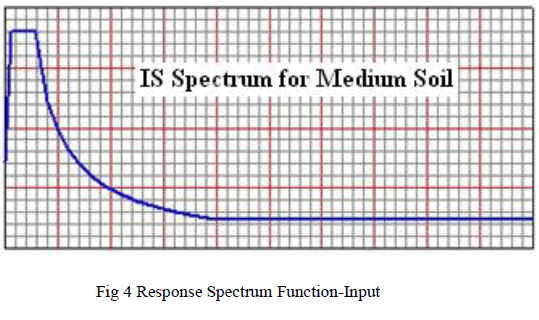 |
RESULTS AND DISCUSSION |
Dynamic Responses |
| The response-spectrum analysis shows the contribution from each natural mode of vibration to indicate the
maximum seismic response in terms of pseudo-spectral acceleration, velocity, or displacement. Table 1 represents the
dynamic response of the building under study. The fundamental time period of the structural system is found to be
0.4259 sec. The response acceleration and displacement are found as 0.9 m/sec2 and 6.6 mm. Generally structures of
shorter period suffer with greater acceleration, whereas longer period structures experience greater displacement. From
the analysis it is observed that the airport terminal building suffers with greater acceleration and also the first mode
participation is more in the dynamic response. These inputs would be useful in the design of structural components
against earthquake loadings. In addition the stresses near the POD element (Fig. 5) may be beneficial to the designers
and engineers to select the suitable materials for truss elements [3]. |
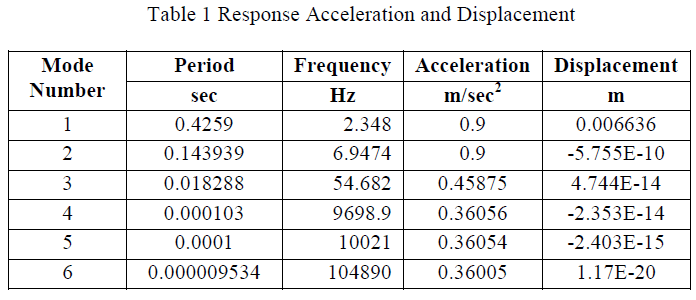 |
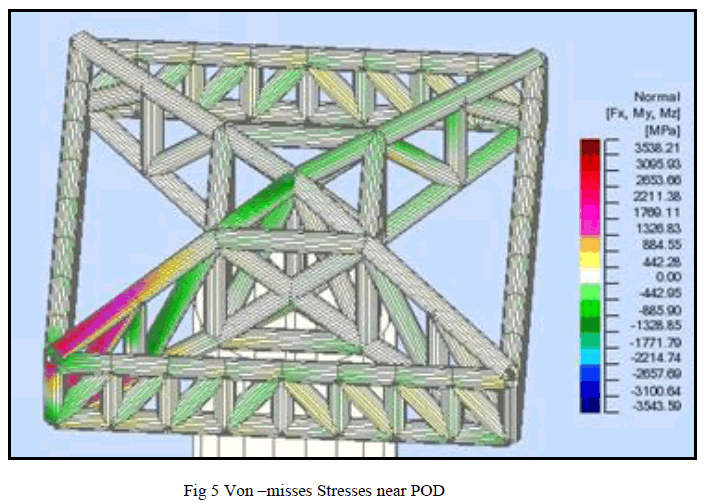 |
CONCLUSION |
| Airport space flexibility depends on the planning and design of structural system. In this paper to fulfil one of the
flexibility criteria the column spacing in the structural system is increased by using advance technique known as POD.
The dynamic analysis of the airport integrated building is carried out using response spectrum method which would
help the engineers for the design of such complex buildings. |
References |
- Beolchini G.C., Galeota D., Giammatteo M.M., Zulli M. âÃâ¬ÃÅSeismic behavior of high strength RC columnsâÃâ¬ÃÂ, 12th WCEE 2000, Auckland, NewZealand,.2000, published by The New Zealand Society for Earthquake Engineering, ISBN 0-9582154-0-5.
- James M. Ricles, Shannon D. Paboojian, âÃâ¬ÃÅ Seismic Performance of Steel-Encased Composite ColumnsâÃâ¬ÃÂ, Journal of Structural Engineering08/1994; 120(8) (ASCE), 0733-9445
- Wei Gao, âÃâ¬ÃÅRandom seismic response analysis of truss structures with uncertain parametersâÃâ¬ÃÂ, Engineering Structures, Volume 29, Issue 7, July2007, pp 1487-1498
- SAP 2000 manual for Response Spectrum Analysis
- MiteshSurana, âÃâ¬ÃÅ Non-linear static analysis using sap 2000âÃâ¬Ã , Department of Earthquake Engineering, IIT RoorkeeIS 1893:2002, Criteria for Earthquake Resistant Design of Structures
|